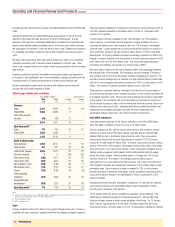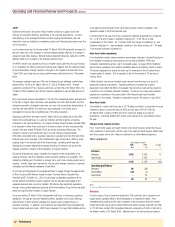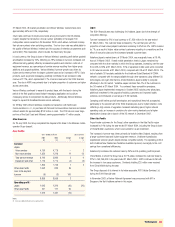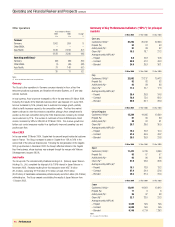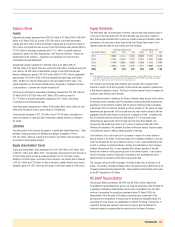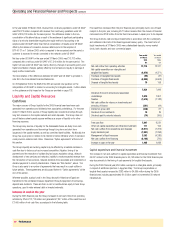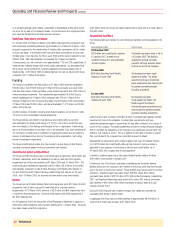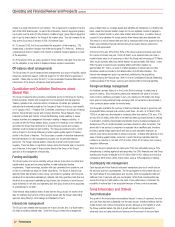Vodafone 2005 Annual Report Download - page 42
Download and view the complete annual report
Please find page 42 of the 2005 Vodafone annual report below. You can navigate through the pages in the report by either clicking on the pages listed below, or by using the keyword search tool below to find specific information within the annual report.
Operating and Financial Review and Prospects continued
40 |Performance
Japan
Vodafone continues to encounter difficult market conditions in Japan due to the
strength of competitor offerings, specifically in 3G customer propositions. A recent
strengthening of the management team and the ongoing transformation plan are
intended to improve Vodafone’s competitive position and financial performance over the
mid to long term.
Local currency turnover for the year ended 31 March 2005 fell marginally compared to
the prior year, with a 5% decrease in service revenue partially offset by an increase in
equipment and other revenue. Service revenue declined following a reduction in ARPU,
partially offset by an increase in the average customer base.
The ARPU erosion was caused by the loss of higher value customers, through the lack
of a competitive 3G offering during the financial year, together with the adverse impact
of lower termination charges caused by changes to the regulatory environment from
1 April 2004 and a total ban on using mobile phones whilst driving from 1 November
2004.
The average customer base grew 4% over the financial year, although market share
declined from 18.4% at 31 March 2004 to 17.3% at 31 March 2005. Prepaid
customers comprised 11% of closing customers, up from 9% at 31 March 2004. By
31 March 2005, Vodafone had 798,000 devices registered to use 3G data services in
Japan.
Non-voice service revenue decreased by 7% over the comparative period, primarily due
to the loss of higher value customers, who generally use more data services, and the
increased proportion of prepaid customers, who can only access basic data services. A
new flat rate data tariff for 3G customers was introduced in the winter and is
anticipated to improve the competitiveness of the data proposition.
Operating profit fell for the year ended 31 March 2005, principally due to the ARPU
dilution, the continued focus on customer retention and the migration of existing
customers to 3G service offerings. The impact of these issues has been partially offset
by a decrease in other direct costs due to a lower provision for slow moving handset
stocks in the year ended 31 March 2005, and other operational efficiencies. The
increase in payroll costs was largely due to one-off charges of approximately
£25 million associated with a voluntary redundancy programme in the first half of the
financial year, which was part of the transformation plan noted below, offset by lower
ongoing costs in the second half of the financial year. Operating profit was also
impacted by increased depreciation charges following 3G network roll out and the
disposal of assets in relation to the integration of regional systems.
During the financial year, Japan completed the majority of the consolidation of its
regional structure, with the integration of key business systems now complete. The
integration of billing and IT systems is a longer term, and more complex project and is
ongoing. Overall, Japan has improved its cost structure through reductions in general
overheads and the effective utilisation of dark fibre.
The Group has strengthened its management team in Japan through the appointment
of Shiro Tsuda and Bill Morrow during the year. Formerly Senior Executive Vice
President at NTT DoCoMo, Inc., Shiro Tsuda brings considerable experience of the
mobile telecommunications industry, together with an extensive knowledge of the
Japanese business and consumer markets. Bill Morrow has significant experience
through various global leadership positions within the Vodafone Group for the last eight
years and was formerly President of Japan Telecom.
In the year ending 31 March 2006, management will focus on enhancing customer
satisfaction, through an improved handset portfolio, targeted new product offerings,
improvements in both network coverage and capacity and a renewed focus on
business customers. In addition, cost reductions are expected through leveraging the
Group’s global scale and scope. With these measures it is hoped that Vodafone will be
more agile and commercially driven when facing mobile number portability in the
Japanese market in the 2006 financial year.
In the first half of the year, the Group increased its effective shareholding in Vodafone
K.K. to 98.2% and its stake in Vodafone Holdings K.K. to 96.1% for a total
consideration of £2.4 billion. On 1 October 2004, the merger of Vodafone K.K. and
Vodafone Holdings K.K. was completed, resulting in the Group holding a 97.7% stake
in the merged company, Vodafone K.K.
Other Asia Pacific subsidiaries
In the Australian market, value promotions and strategic changes in the tariff structures
led to Vodafone increasing market share, turnover and profitability. ARPU also
increased, despite falling prices, due to increased usage. In August 2004, Vodafone
announced an agreement with another Australian telecommunications carrier to share
3G network equipment to reduce the total cost of ownership of the 3G network and
increase speed to market. This is expected to lead to the launch of 3G services in
October 2005.
In New Zealand, turnover and market share improved over the year as a result of
enhanced customer propositions. Operating profit also increased as reduced
equipment costs offset the effect of increased interconnection costs as the proportion
of activity to non-Vodafone networks increased. The launch of a high speed network
upgrade by competitors in the second half of the financial year has intensified
competition in the market. Vodafone is expected to launch 3G services in July 2005.
Other Asia Pacific
China Mobile, in which the Group has a 3.27% stake, and which is accounted for as an
investment, grew its customer base by 42% over the year to 213,874,000 at
31 March 2005, including 26,831,000 from customers added as a result of
acquisitions. Dividends totalling £18 million were received from China Mobile during
the year.
Changes to the regional structure
From 1 April 2005, Japan will report directly to the Chief Executive whilst the Group’s
other operations in Asia Pacific will form part of an extended Other Europe, Middle East
and Africa region, which will in future be referred to as Other Mobile Operations.
Other operations
Years ended 31 March
2005 2004 Change
£m £m %
Turnover
Germany 1,108 1,002 11
Asia Pacific –1,126
1,108 2,128 (48)
Operating profit/(loss)(1)
Germany 66 (58)
Other EMEA (37) (1)
Asia Pacific –79
29 20 45
Notes:
(1) before goodwill amortisation and exceptional items
Germany
In local currency, Arcor’s turnover increased by 14%, primarily due to customer and
usage growth, partially offset by tariff decreases in a competitive market. Arcor
strengthened its position as the main competitor to the incumbent fixed line market
leader during the year growing contract ISDN voice (direct access) customers by 83%
to 712,000 and contract DSL (broadband Internet) customers by 169% to 455,000 in
the twelve months to 31 March 2005. Market share in the fast growing broadband










